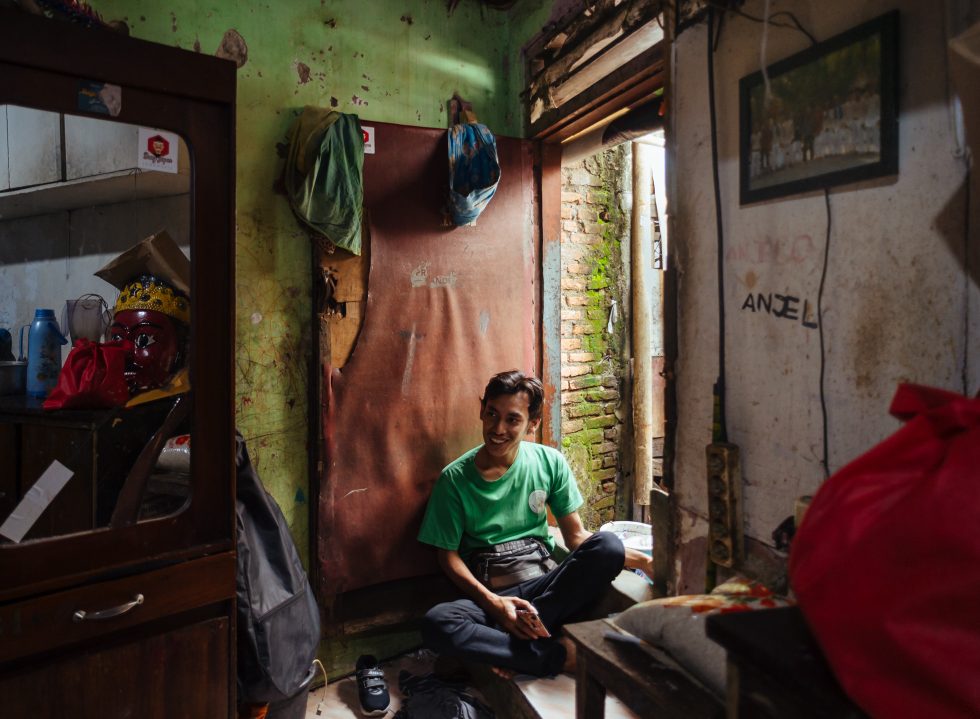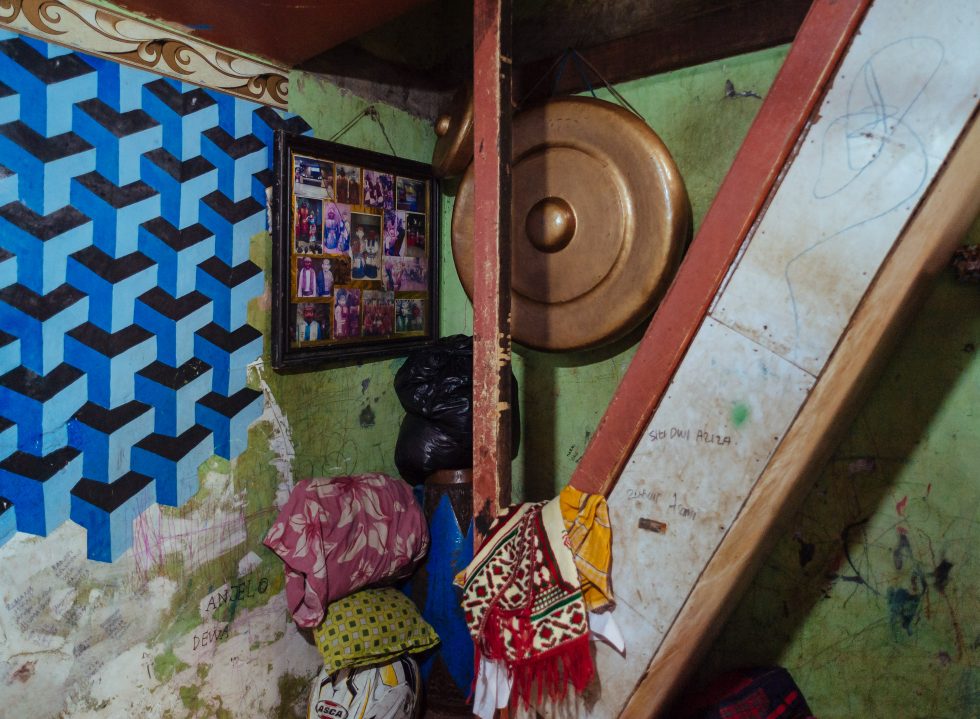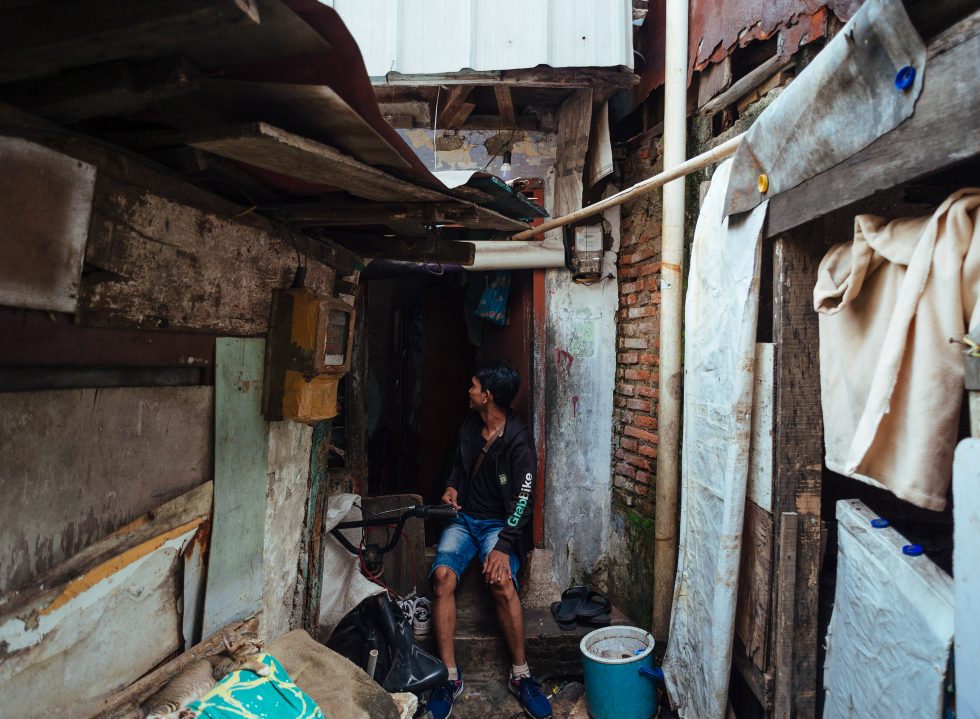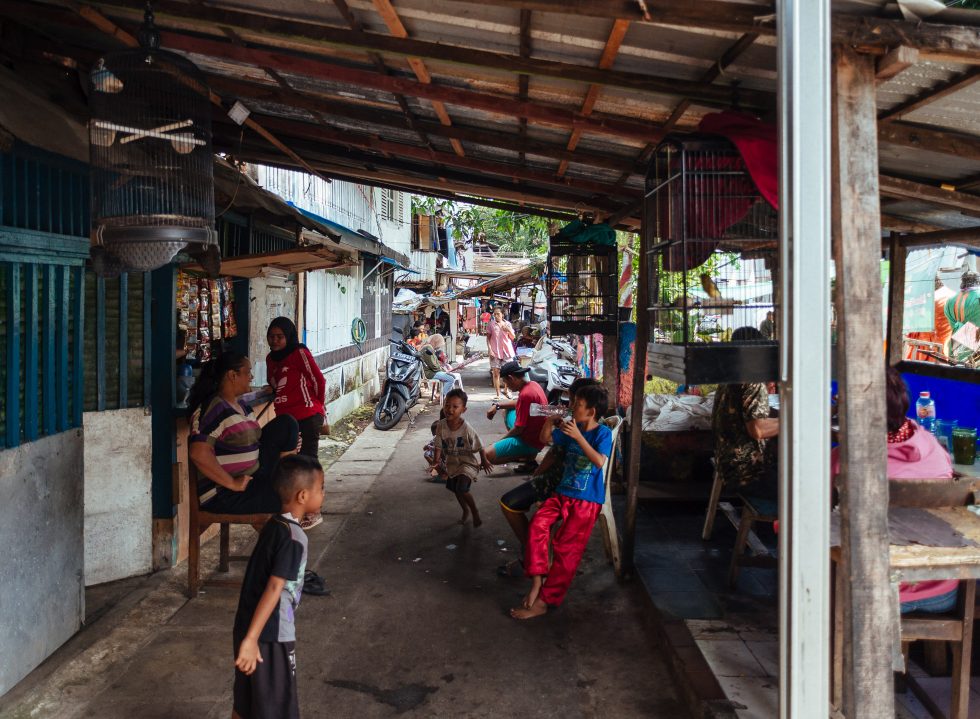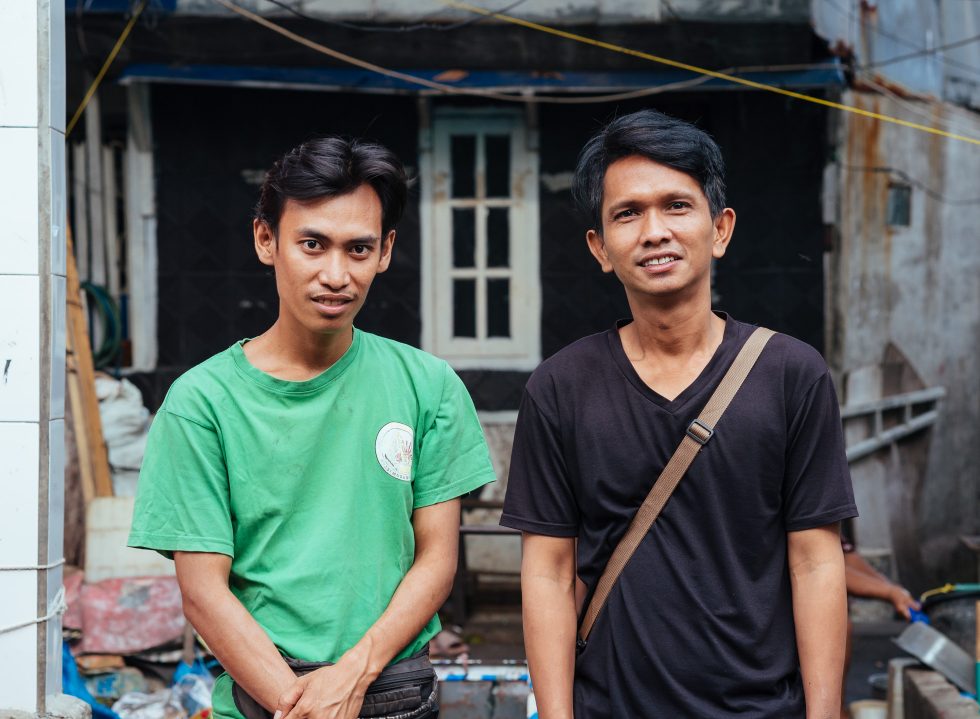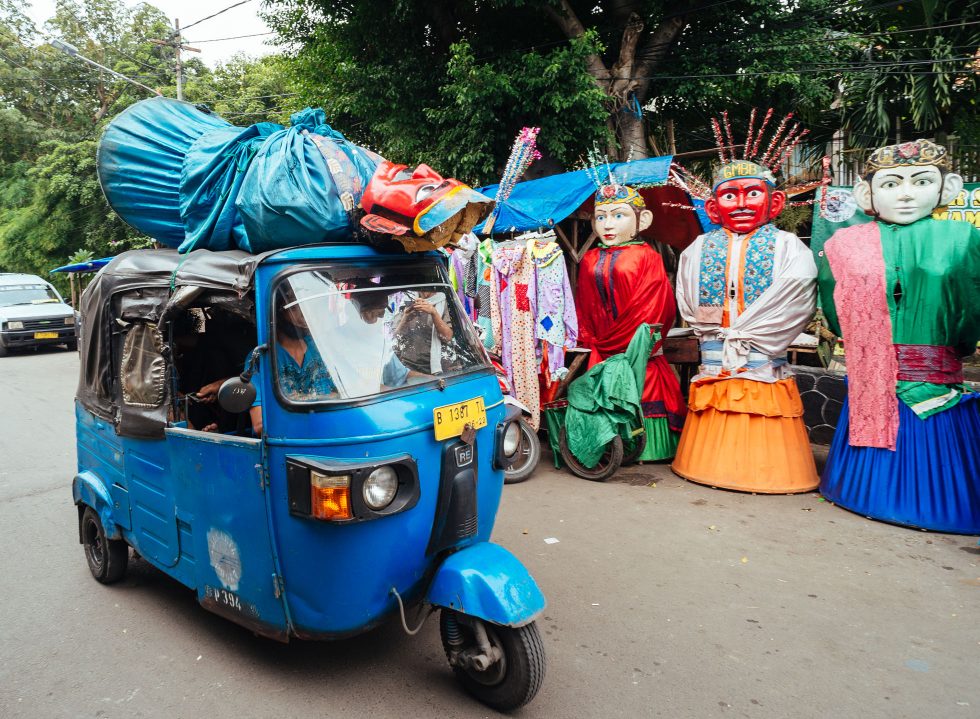The afternoon was slow and gloomy in Senen, Central Jakarta, but the people of Kampung Ondel-Ondel on Kembang Pacar street were abuzz with the previous day’s excitement. Home to numerous ondel-ondel (Betawi puppet figure) artists, the urban village acted as host to one of Indonesia’s renowned, albeit controversial, figures: “Hotman Paris did a shoot here with Trans 7 last Tuesday,” they all said.
Troops of children roamed the lively streets as they engaged in a game of football in the shade of the looming figures of their silent neighbours, the ondel-ondel. Many of them eerily stood headless, stripped of their colourful red (for male) and white (for female) masks.
“We always remind the kids to take off the masks from the body,” said Oki, one of the ondel-ondel artists. “Otherwise, they would get struck by the wind, fall and break. The good masks that we use for events we keep on the third floor [of our headquarters]. But for the bodies, we don’t have a shed to store them, so we just leave them on the streets. We tie them up in case of flooding, which usually happens when it’s raining hard.”
“These [ondel-ondel] marches are a big part of Betawi culture, and we do it to preserve this sense of connection amongst our people who live in far corners of the city.” – Abdul Halif, one of the leaders of Mamit CS
Oki is a member of Sanggar Betawi Mamit CS, a strictly-family-and-friends-only community focused on the preservation of Betawi culture and the oldest ondel-ondel group in the district, founded by the late Abdul Hamid, aka Mamit. On the regular, he leads the ‘nephews’, the newer generation of the group, as they go on busking marches with their ondel-ondel and traditional music from one urban village to another.
“Nobody knows how ondel-ondel started, exactly. It’s just something that has always been around from one generation to the next. These [ondel-ondel] marches are a big part of Betawi culture, and we do it to preserve this sense of pride and connection amongst our people who have been pushed to the side and live in far corners of the city and beyond. But the government has misinterpreted our intention, thinking that we want to invade the strictly regulated streets. When in reality, we’re just making our way from one village to the next,” explained Abdul Halif or Alif, Mamit’s fifth child and one of the leaders of the group.
“That said, while the history of ondel-ondel itself is unclear, I can confidently say that in this Pasar Gaplok area, my dad was one of the pioneers,” the man added. “He took inspiration from a man called Pak Umar, who used to make his ondel-ondel masks with metal sheets. He was truly the first one here, unfortunately, none of his descendants was interested in continuing his legacy.”
Mamit, his friends and the birth of Kampung Ondel-Ondel
Mamit CS’ rented HQ can be found half-hidden in the alleyway that leads deeper into the densely packed urban village. The compact three-story house is also the living quarters of Mamit’s wife Nurjanah and some of their children, grandchildren as well as a few of their young nephews and nieces.
Inside, timeworn photographs of ondel-ondel captured old memories from the days when Mamit was still in charge. The content and discolouration suggest they were taken sometime in the early 2000s, but the history of Mamit CS stretches further back. While the current group was founded in 1984, before its formation, Mamit had been actively performing the art of ondel-ondel in another group known as Lima Sekawan (five friends).
The older group predates the time when ondel-ondel had an image transformation. Before famed comedian and singer Benyamin Sueb released his hit song ‘Ondel-Ondel’ in the early 70s, the puppets were known as barongan. A taller, more menacing presence that used to terrorise women and children (or any who dared mock it to its face) with a dangerous game of tag that could result in injured heads and victims falling into a river.
But among each other, Mamit and his friends kept it friendly. “CS in Mamit CS stands for cinta setia kawan (love among loyal friends), a theme taken from the older group,” shared Alif.
His younger cousin and fellow Mamit CS leader, Taufik Hidayat—also known as Topik—chimed in, “The naming of Kampung Ondel-Ondel is just something new that we came up with in 2018, as an effort to sustain the legacy of these five pioneers, which were my uncle, Babe Andi, Kong Agus, a second Mamit, and Kong Maman.”
The struggle of preserving the culture
Perhaps even more than Mamit’s eight children, Topik would be the most knowledgeable when it comes to the struggle of keeping such a legacy alive. “My late husband used to take him everywhere, and it began when he was very young. He was the only one who was interested in learning about the Betawi culture,” recalled Nurjanah. Topik, now 25, has since continued to make use of his uncle’s teachings to ensure that Mamit CS gets the bookings and orders it needs.
Economical constraints and lack of access are a real issue among ondel-ondel artists, and by extension, any who seek to preserve other aspects of the Betawi culture. Housing disputes, managing multiple jobs, restrictive regulations, and the lack of bookings during the pandemic are among the obstacles they face on the regular. For one, Pia, Mamit’s sixth child, had to give up her Betawi-style culinary kiosk. She now sells clown costumes for street buskers off a pick-up truck on the main street, sparking a contrast against her brother and cousin’s ondel-ondel creations.
“Nowadays, people prefer to go busking in a clown costume because it’s easier. It’s light, and you can do it on your own. No matter how much you get, you get to keep it for yourself. I have to make a living after all, that’s why I sell these costumes now. As for ondel-ondel, I’ll leave that to the boys,” shared Pia.
Embracing the changes
In the face of it all, able members of the family keep pushing and promoting their culture and craft. Mamit’s eldest son Jafar made connections with the local government, negotiating for space and security for the sake of the cultural venture. Meanwhile, Alif and Topik have continued to send letters to those in charge to make Kampung Ondel-Ondel an official, government-supported destination for those seeking to learn about the Betawi culture.
And the family’s efforts do pay off in their own way. “Even though we won’t be able to do marches anymore sometime in the future, the governor has thankfully reserved several spots in the city like Taman Ismail Marzuki, Tebet Eco Park and Kota Tua for us to perform. But we don’t know if that would change with a change of personnel, and it’s something that we remain wary of,” told Alif.
Beyond local efforts, Mamit CS has also stretched his influence internationally, receiving guests from countries like Japan and Korea who are interested in their craft—something that was hard to do before the advancement in technology.
“Orders were plenty, but it was all word of mouth. Foreigners looking for my father’s place had a difficult time at it,” recalled Alif. To which, Topik added, “Things are different now. We have to make use of what we can, and we can’t keep hanging on to the past, otherwise, we’ll never grow.”
With an information-packed business account on WhatsApp, an Instagram profile and a Youtube channel, nowadays, it’s quite easy to get a hold of the group. So far, queries have ranged from performances like Gambang Kromong (traditional orchestra) and Palang Pintu (a martial arts style) as well as orders of local cuisines like dodol (palm-based chewy sweets) and the popular kerak telor (a spicy omelette dish).
“When it comes to ondel-ondel masks, every craftsman has their own signature material. Each area has its own version.” – Taufik Hidayat, fellow leader of Mamit CS
Nevertheless, ondel-ondel remains the main attraction at Mamit CS. Beyond events like weddings, birthdays and even presidential proceedings and offering rituals, the group also makes the puppet for order. Each one is individually handcrafted, Alif is tasked with the body and Topik the trickier masks.
“The key to making masks is to do it at the right temperature,” explained Alif. “The day needs to be scorching hot, as we need the fibreglass to dry and harden. When it comes to forming it, we already have a master mould made of clay.”
“While we make our masks with fibreglass now, my uncle used to make them with newspaper pulp,” Topik added further. “Every craftsman has their own signature material. There was this Pak Kerbau in Rawa Sari who made his masks with carved wood that still has traces of flowers growing from it—so it’s fragrant. But that’s just between craftsmen, each area has its own version. In Tangerang, their masks have headbands instead of coconut flowers like ours in Central Jakarta and the ones in Bekasi. And our coconut flowers are numbered in a way that instils Islamic values to the puppet, as part of an agreement with the Muslim Betawi leaders here.”
Indeed, “When it comes to ondel-ondel, every community has their own ideas, and there’s just no end to the topic,” Topik concluded.

